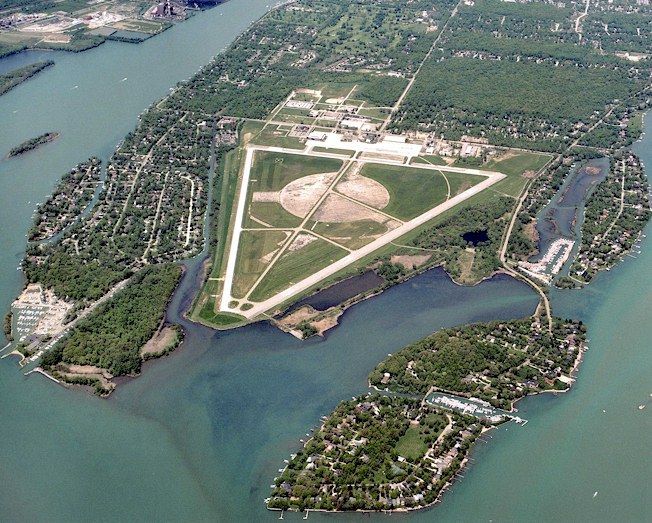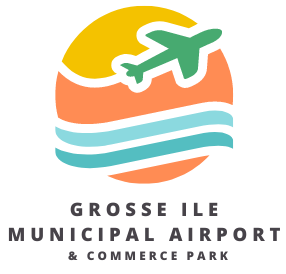Fire Safety Requirements
FIRE SAFETY REQUIRMENTS FOR AIRCRAFT STORAGE IN HANGARS AND T-HANGARS
- The International Building Code (IBC 2000) and the International Fire Code (IFC 2000) and all National Fire Protection Associations NFPA Codes, Standards and Guides currently adopted by Grosse Ile Township mandates that the primary use of T-hangars shall be storage of aircraft and aircraft related parts, tool and maintenance supplies. T-hangars are classified as (IBC) S-2 structures. User shall not store supplies or items of any nature other than aircraft related parts, etc., in hangars, buildings, or on the grounds without first securing permission from the Manager and/or paying such fees as would apply for such storage. A maximum of one automobile and one boat (or any combination not exceeding two of the above listed items) may be stored in a T-Hangar if each item is in a “winterized” condition (if the battery has been removed and the permanently installed fuel tanks are full).
- Storage of fishing boats, personal watercraft, and motorcycles are allowed assuming recreational vehicle is in a “winterized condition.” Storage of one of these recreational vehicles counts against the two (2) allowed vehicle or boat requirement listed in paragraph one (1). Recreational Camper (RV) storage is/ is not permitted (Fire Department Discretion). Storage of one (1) snow blower is allowed and does not count against the above two (2) allowed vehicle rule.
- Portable fuel tanks for boats or personal watercraft must be completely empty.
- All buildings are subject to regular and unannounced inspections by the Grosse Ile Fire Department for safety compliance with the Michigan Building Code and National Fire Protection Association (N.F.P.A) Article 409.
Additional Regulations:
- Temporary wiring is prohibited
- Except as identified above, no other non-aircraft (i.e. personal or household) items may be stored in hangars.
- User shall not store any flammable liquids at any time, except such material contained within the fuel tanks, engine of the aircraft or in an Underwriter Laboratories, Inc. (UL) approved type I safety container. A combined maximum of 5 gallons of flammable liquids (e.g.. aviation fuel or auto gas) stored in containers approved for the particular fuel and up to forty-eight (48) unopened quart containers of aviation oil may be stored in any one T-hangar at a given time. Storage of waste oil/hydraulic fluids are prohibited. Oils and lubricating materials shall be disposed of in the designated waste oil disposal tank. The fuel tanks of non-aeronautical vehicles, seasonal craft and/or equipment stored in hangars shall be kept FULL. The storage of kerosene is prohibited.
- Waste oil, used oil filters, used fuel filters, cleaning liquids, oily rags and other used fluids and flammables shall not be stored overnight. Such items and materials shall promptly be removed from the hangar for proper disposal as hazardous material.
- Spray painting inside of the hangar is prohibited. The use of flammable cleaners is prohibited inside the hangars. No paint thinners, solvents, or other flammable liquids may be stored in a hangar unless in an approved flammable liquid safety cabinet.
- Open flames, flame-producing devices and other sources of ignition shall not be permitted in hangars.
- Approved propane fired engine heaters are exempt from rule (F) but are only to be used when main hangar door is in a fully open position.
- No open-flame space heating devices may be stored or used in a hangar (i.e. kerosene turbo space heaters and propane fueled space heaters).
- Approved electrical devices for heating aircraft engines (i.e. engine block or oil heating) may be left operational in a hangar when not attended as long as the device is directly connected to one(1) approved grounded extension cord directly connected to wall outlet provided. Power strips and multi-tap outlets are not permitted. Used of electrical heat tape for engine pre-heating not permitted.
- Storage and use of UL or FM approved electrical extension cords is permitted provided the cord is disconnected and stored when the lessee or the lessee’s representative is not present; however, use of an electrical extension cord for an operating pre-heater or battery charger is permitted. The extension cord shall be disconnected and stored when the pre-heater or battery charger is not operating. Electrical devices requiring more than a maximum of 15 amps shall not be plugged into electrical receptacles. Service cords shall match requirements.
- Light bulbs used for drying aircraft interiors shall meet the following requirements:
- Light bulb shall be protected from breakage with a metal or fire-resistive guard.
- Light bulb not to exceed 150 watts.
- Light bulb shall be secured to provide a minimum of 18” clearance from interior combustible materials.
- Portable halogen lamps are prohibited for interior use.
L. Electric space heaters used for drying aircraft interiors shall meet the
following requirements:
- Heater shall be UL approved.
- Heater shall be equipped with a thermal cutoff.
- Heater shall be equipped with a tip safety device.
- Heater shall not exceed 1000 watts output.
- Heater shall not be placed on aircraft seating.
M. Parking of tenant vehicle in the hangar is permitted while the aircraft is
removed for Flight
o. Aircraft maintenance is permitted in the hangar provided the area is kept neat, orderly and clean.
q. An operational refrigerator may be maintained in a hangar for the tenant’s convenience, if it is connected to a wall outlet per code.
r. Storage and use of UL or FM approved electrical extension cords is permitted provided the cord is disconnected and stored when the lessee or the lessee’s representative is not present; however, use of an electrical extension cord for an operating preheater or battery charger is permitted. The extension cord shall be disconnected and stored when the preheater or battery charger is not operating. Electrical devices requiring more than a maximum of 15 amps shall not be plugged into electrical receptacles. Service cords shall match requirements.
s. Items stored in addition to the aircraft shall be placed such that movement within the hangar is not restricted. Passageways and access paths for hangar or aircraft use and egress shall not be restricted or encumbered.
t. Tenant shall not defuel, or refuel aircraft or transfer fuel from one vessel to another in the hangar. See Section 600.1
u. No wooden lofts or permanent wooden shelving are allowed in a hangar. No upholstered, wooden, or plastic furniture may be stored in a hangar. Furniture to be used for a lounge area will be permitted only if inspected and approved by the Fire Department.
v. Smoking shall be prohibited in aircraft refueling vehicles, aircraft hangars and aircraft operational areas.
w. The aircraft operation area (AOA) and related areas shall be kept free from combustible debris at all times.
x. Additional: Tenant shall insure lights are turned off when exiting the hangar. Tenant will be issued a key for the hangar doors. Replacement keys are available as needed from the Airport office for a $10.00 replacement fee.
It is the responsibility of each tenant to initiate steps to achieve and maintain compliance with these rules. If you have any questions feel free to contact the Fire Marshall at 734.676.5386 or the Airport Manager at 734.675.0155
SECTION 600.1 - FUELING OPERATIONS
All fueling operations shall conform to the provisions of N.F.P.A and the following:
- During the fueling or de-fueling of any aircraft:
- User shall not smoke within fifty (50) feet of such aircraft.
- User shall not operate any radio transmitter or receiver or switch electrical appliances on or off in aircraft being refueled.
- User shall not use any material or equipment that is likely to cause a spark or ignition.
- User engaged in fueling shall have a suitable fire extinguisher available.
- Except where specifically excepted by the FAA an aircraft engine shall not be started, running or warmed by applications of exterior heat during fueling.
- Except where specifically excepted by the FAA, persons shall not be in an aircraft while it is being refueled.
- Aircraft shall not be fueled while in a hangar or enclosed space. Aircraft shall be pulled entirely outside of the hangar prior to being fueled.
- Aircraft fueling shall begin only after the grounding cable has been connected between the aircraft and the fuel dispensing system.
- Fueling shall cease if the grounding cable becomes disconnected.
- When defueling aircraft tenant shall contact the airport office to inform them of this event. Airport Manager shall contact Grosse Ile Fire Department to inform them of this event.

